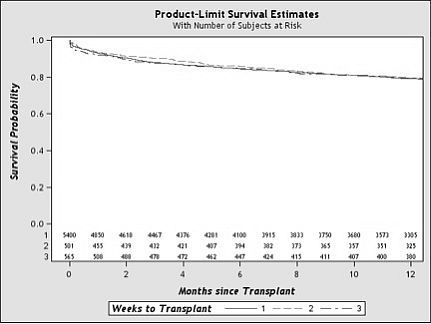Time on Waiting List for Patients with High MELD Does Not Influence Graft or Patient Survival after Liver Transplantation
Northwestern University, Chicago
Meeting: 2013 American Transplant Congress
Abstract number: D1640
BACKGROUND: With the decreased donor availability, even patients with high MELD scores can have prolonged wait times for liver transplantation (LT). However, it is unknown whether prolonged wait times have negative impact on patient and graft survival after LT. We aimed to determine whether patients that have had prolonged waiting times for LT with a high MELD have worsened outcomes after LT.
METHODS: We conducted a secondary analysis of the Organ Procurement and Transplantation Network database for adult LTs. We included all recipients transplanted with any MELD score >35 prior to transplant (n=6,466) and split the cohort into 3 groups based upon time on waiting list prior to LT once the MELD of 35+ was obtained. We compared risk-adjusted graft and patient survival for waiting times of 1 week, 2 weeks or 3+ weeks.
RESULTS: The mean age of the cohort was 52.5 ± 9.6 yo, predominantly non-Hispanic white (65.0%) and male (68.5%). The mean MELD score was 36.7 ± 7.4 and 42.9% HCV seropositive. The mean donor age was 39.4 ± 16.0 with a mean BMI of 26.7 ± 5.6 and a mean cold ischemic time of 7.1 ± 3.5 hrs. The Kaplan-Meier curve for graft survival for patients transplanted at week 1, 2, and 3+ is shown in Figure 1.

(p=NS)
Overall unadjusted one-year patient and graft was 72.1% and 68.7%, respectively. The risk-adjusted analysis showed no significant difference in patient and graft survival at 1 months, 6 months, and one-year when comparing the three cohorts. Those patients who waited to 3+ weeks did have a significant drop in mean MELD score to 26.7± 5.8.
CONCLUSIONS: For those patient with a MELD score of 35+, time on the waiting list does not influence patient and graft survival after liver transplantation. This suggests that those patients that are still deemed transplantable going into LT with a high MELD, have comparable graft and patient survival after LT, despite the prolonged waiting time. Dynamic changes in MELD score could account for the comparable outcomes in these patients, which likely a marker of physiologic reserve. Further studies looking at specific predictors of patient and graft survival for patients with high MELD are ongoing.
To cite this abstract in AMA style:
Parikh N, Lapin B, Abecassis M, Baker T. Time on Waiting List for Patients with High MELD Does Not Influence Graft or Patient Survival after Liver Transplantation [abstract]. Am J Transplant. 2013; 13 (suppl 5). https://atcmeetingabstracts.com/abstract/time-on-waiting-list-for-patients-with-high-meld-does-not-influence-graft-or-patient-survival-after-liver-transplantation/. Accessed December 17, 2025.« Back to 2013 American Transplant Congress
